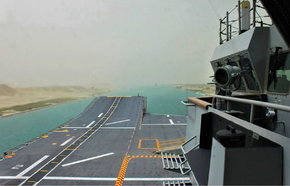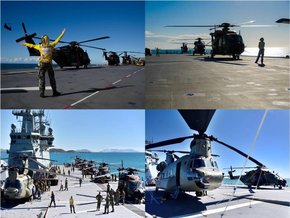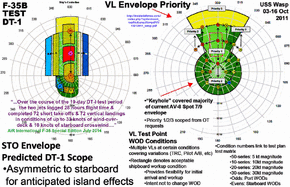Navantia | Strategic Projection Ship | LHD “Juan Carlos I”
“...The “JUAN CARLOS I” is a single hull ship made of steel with the superstructure on the starboard side. Her design is based on a combination of military and commercial standards and specifications; the structure, equipment and materials follow Lloyd’s Register of Shipping’s civil standards, whilst her combat system, ordnance handling and stowage systems, systems of supply at sea, flight deck and the damage control system follow military standards. The ship as being designed with four mission profiles:
AMPHIBIOUS SHIP: Capable of transporting a Marine Infantry Force to carry out landing , supporting operations on land.
FORCE PROJECTION SHIP: Transporting forces of any army to a theatre of operations.
AIRCRAFT CARRIER: A temporary platform for carrier-based naval aircraft, acting as a flight deck for strategic projection airborne vectors (Navy’s Air Wing), capable of becoming a temporary platform to substitute the aircraft-carrier, “PRINCIPE DE ASTURIAS”, when she is not available due to downtime (repairs, modifications, etc.).
HUMANITARIAN AID OPERATIONS SHIP: NON-WAR operations, humanitarian assistance, evacuation of crisis areas, hospital ship in areas affected by natural disaster, etc.
...For its part, the runway has a 12° gradient or ski-jump afore to facilitate the takeoff of STOVL & to improve the loading capacity of fuel & weaponry....
...In a significant qualitative leap, this ship is also designed to operate with the STOVL version of the JSF, the F-35B Lightning II, if the Spanish Navy decides to acquire this exceptional plane. A touchdown point has also been reserved astern of the flight deck that is specially adapted (in dimensions & resistance) for the special needs of the new V-22 Osprey tilt-rotor aircraft. For the transfer of aircraft between the hanger and the flight deck, the Juan Carlos I has two elevators, each with a capacity of 25 tonnes and sufficient size to be able to carry up to the new F-35B Lightning II, or a helicopter the size of a Chinook. The capacity of the hangar is variable depending on the mission profile. This means an area of 1,000 m2 would be available for an amphibious type profile. This surface area could be increased by a further 2,046 m2, using the upper garage to have greater capacity for the aircraft. This means the hangar would reach 3,000 m2 for an
aircraft carrier type profile. The hanger itself, situated further astern, can house up to 12 medium-sized helicopters. In the case of the LHD operating as a temporary aircraft carrier, the vehicles and material would be substituted by between
10 and 12 STOVL planes, as well as the dozen helicopters previously mentioned. In order to provide support for airborne operations, it is estimated that the ship has sufficient fuel, spare parts and arms so that the embarked aircraft could carry out their operations without the ship needing replenishment for up to a maximum of 50 days.
The planned airborne capacity is for her to transport and operate up to 30 aircraft including medium-sized and heavy helicopters in amphibious operation profiles, or between
10 and 12 F-35B planes or AV-8B+, plus a similar number of medium-sized helicopters when acting with an aircraft carrier mission profile at times when the Príncipe de Asturias R-11 is not operational....”
http://www.navantia.es/ckfinder/userfiles/files/sala_pr/folleto LHD_marzo_para navantia_ingles.pdf



